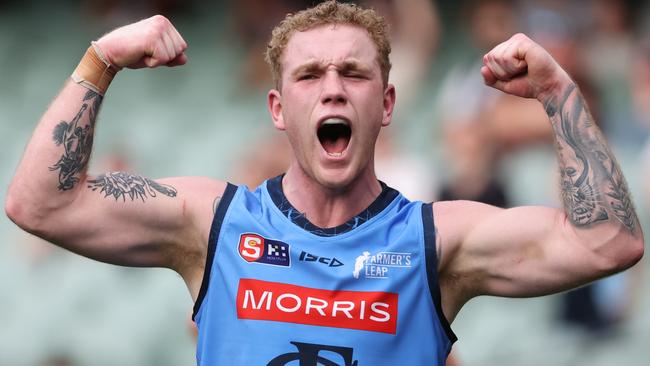SANFL’s three-year pay rise plan as salary cap rises to pre-Covid levels
SANFL players are set for a cash boost, with the league unveiling a three-year plan to return the salary cap to pre-Covid levels.
Local Footy
Don't miss out on the headlines from Local Footy. Followed categories will be added to My News.
The SANFL salary cap is on the rise.
With Covid cost-cutting restrictions in the rear-view mirror, the SANFL has formulated a three-year plan designed to bring the salary cap back in line with pre-Covid figures.
The league will raise its salary cap for the eight standalone SANFL clubs – Central District, Glenelg, North Adelaide, Norwood, South Adelaide, Sturt, West Adelaide and Woodville-West Torrens – by $15,000 each season for the next three years.
With additional allowances included, this will take the salary cap to $375,000 – $25,000 less than the $400,000 that was in place in 2019 before Covid hit and caused major financial ramifications for the league and its clubs.
“Following consultation with the eight clubs, we have adopted a three-year plan to raise the men’s salary cap by $45,000 incrementally over the next three seasons to provide some surety to SANFL clubs when building their playing lists,’’ SANFL executive general manager of football Matt Duldig said.

“The economic impact of the past three years with Covid has been challenging for both SANFL and its clubs and, ultimately, we must ensure clubs can continue to be viable and successful into the future.
“Importantly we need to balance an appropriate reward for State League players through affordable and attractive player payments with financial sustainability across all SANFL clubs.”
After the salary cap was scrapped in the short, Covid-ruined 2020 season when players played only for the JobKeeper payment, it was reduced to $210,000 in 2021 and 2022 (plus $45,000 in allowances) as the league and clubs counted the cost of lost revenue because of Covid restrictions.
This year the salary cap jumped to $260,000 plus $70,000 in allowances, which sit outside the basic salary cap and include player coaching, relocation, marketing and milestone components.
The milestone payments reward players for reaching 50, 100, 150, 200 and 250 games and have helped keep some of the SANFL’s finest players in the competition.
With the allowances, each club’s total salary cap will be $345,000 in 2024, $360,000 in 2025 and $375,000 in 2026.
The league will then reassess its position, particularly with the potential reintroduction of an AFL reserves competition, which would likely see Port Adelaide and Adelaide, who field their reserves teams in the SANFL, fly the State League coop.


The salary cap increases are important in maintaining the SANFL’s hold as the best Australian football league outside of the AFL and keeping players in the competition.
The drop in salary cap since Covid has contributed to some quality footballers playing in lesser competitions as they weigh up the financial returns for their time investment, which can include four training sessions a week while they hold down full-time jobs.
Many SANFL players only make about $5000 a year from their football, with marquee players earning about $25,000.
This is in stark contrast to AFL players, where the average wage this year was $406,000 – higher than a SANFL club’s total player wage bill.
AFL clubs had a salary cap of $14.7 million in 2023.

Some big names have departed the SANFL this off-season, although most are veterans in the twilight of their careers.
They include South Adelaide’s Bryce Gibbs, Matthew Broadbent, Matt Rose, Zach Sproule and Ely Smith, Norwood’s Nik Rokahr and Matthew Nunn, Glenelg’s Max Proud and Luke Partington, North Adelaide’s Aaron Young, Cameron Craig and Andrew Moore, Adelaide’s Matthew Wright, West Adelaide’s Jono Beech, Woodville-West Torrens’ Jimmy Toumpas, Central District’s Justin Hoskin and Luke Habel and Port Adelaide’s Cam Sutcliffe.
But, as usual, there will be an influx of interstate recruits.
Those already signed include former AFL-listed men Cooper Murley and Alastair Lord (Norwood) and Arlo Draper (South), who have returned to their original SANFL clubs.
The Redlegs, who slumped from premier last year to seventh this year, have been very active, signing a host of recruits, including state midfielder Mitch O’Neill from South, Jordon Boyle from West, Essendon VFL captain Billy Cootee, North Launceston’s Ben Simpson and Murray Bushrangers’ Joeve Cooper.





